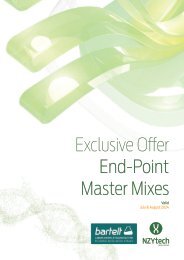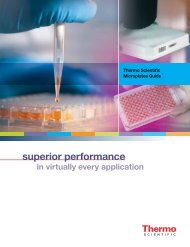PeloBiotech
Create successful ePaper yourself
Turn your PDF publications into a flip-book with our unique Google optimized e-Paper software.
www.pelobiotech.com<br />
3D Skin Model<br />
What is CellApplications’ 3D Skin Model?<br />
It is a highly physiological, three-dimensional cellular system of Human Epidermal Keratinocytes (HEK) for in vitro studies,<br />
offering an excellent cellular system to examine aspects of epithelial function and disease, particularly those related to skin<br />
biology and toxicology.<br />
Advantage: Basic science and pharmaceutical researchers use the 3D Skin Model to replace animal tests for the assessment<br />
of skin irritation due to chemicals, skin-cream- based drugs and cosmetics.<br />
Application: CAI's Skin Model can also help avoid misclassification of chemicals and skin corrosion observed in animal<br />
systems (1, 2). Other applications include phototoxicity, percutaneous absorption & penetration, wound healing and<br />
metabolism. The cells are grown and differentiated into a stratified squamous epithelium on PCF inserts with a liquid/air<br />
interface. Contact us for more information.<br />
1) Eun & Nam, Exog Dermatol, 2:1–5 (2003)<br />
2) York et al., Contact Dermatitis, 34:204 (1996<br />
A. Depiction of Human Skin.<br />
B. Human Epidermal Keratinocytes (HEK) at ~80% confluency.<br />
C. Crystal Violet Staining.<br />
D. Hematoxylin & Eosin Staining of HEK differentiated into stratified squamous<br />
epithelium after 14 days.<br />
3D Airway Model<br />
What is the 3D Airway Model?<br />
It is a highly physiological, three-dimensional cellular system of Human Bronchial Epithelial Cells (HBEpC).<br />
Application: It is used for in vitro examination of epithelial function and disease, including airway infections, tissue repair<br />
mechanisms, signaling changes and potential treatments relevant to lung injuries, mechanical and oxidative stress,<br />
inflammation, pulmonary diseases and smoking. The cells are grown and differentiated into a pseudostriated epithelium<br />
on PCF inserts with a liquid/air interface.<br />
Fig A. Depiction of Human Airway.<br />
Fig C. Crystal Violet Staining.<br />
F i g D. Hematoxylin & Eosin Staining of HBEpC differentiated into<br />
pseudostriated epithelium after 28 days. (pic: CA)<br />
F i g B. Human Bronchial Epithelial Cell (HBEpC).<br />
The 3-D airway model is available as 12 or 24 well do-it-yourself-kit. The cells will<br />
be delivered cryopreserved.<br />
56
















